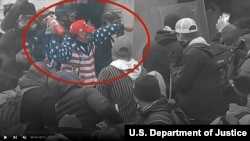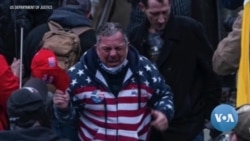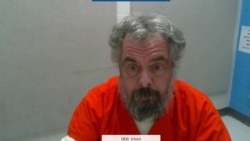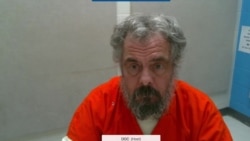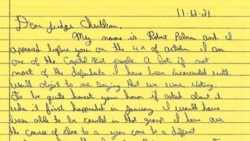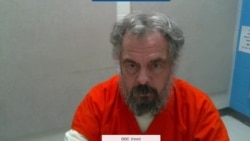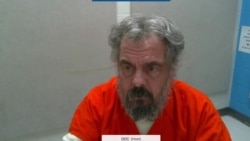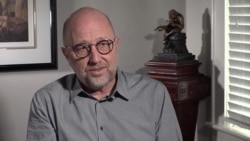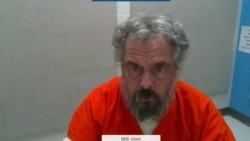Robert Scott Palmer did not carry weapons with him to the U.S. Capitol. Yet, they found him. Surveillance video shows him empty-handed as he arrived at the Capitol on the afternoon of Jan. 6, 2021. He says the common objects he used as weapons against police just appeared at his feet.
“When I got a face full of pepper spray, I bent down to wipe my eyes,” says the 54-year-old Largo, Florida, resident. “The fire extinguisher was right there at my feet. I didn’t go searching for it. It was literally right by my feet.”
Palmer sprayed the fire extinguisher’s contents at Capitol Police officers protecting the building and threw the empty canister at them, along with other “weapons.”
He says he got “caught up in the moment.”
To date, he has received the harshest sentence of all the January 6 inmates.
Palmer, who is serving 63 months for his role in the breach of the Capitol, granted an exclusive 90-minute interview to VOA’s senior Washington correspondent Carolyn Presutti from the Washington, D.C., jail where he is awaiting transfer to prison. Presutti spoke to Palmer by videoconference from the Florida office of his defense attorney, Bjorn Brunvand.
Palmer sits at a table wearing an orange V-neck tunic and orange pants. His beard is graying, and his hair is long and disheveled. He says for his five months of incarceration, the jail has not allowed inmates to trim their hair or shave.
"Most of the guys on my pod, they look like me," he says.
Palmer is one of more than 750 people charged in the violence, as a mob forcibly tried to enter the Capitol to disrupt certification of the 2020 presidential election. More than 220 have pleaded guilty. Twenty-six, like Palmer, pleaded guilty to felonies.
Tuesday, March 8 brought guilty verdicts in the first trial arising from the insurrection.
Guy Reffitt of Texas brought a gun and zip ties to the Capitol uprising. He was convicted on all five counts he faced, including transporting a firearm in support of civil disorder, remaining on restricted grounds with a weapon and obstruction of justice for threatening his family with bodily harm if they spoke to the FBI.
The Federal Bureau of Investigation is still searching for 350 others who broke the law. The FBI is asking for the public’s help to identify men and women through social media, news videos and photos posted on the Most Wanted page for the U.S. Capitol Violence.
Only stopped by rubber bullets
The fire extinguisher was not the only item Palmer hurled at police. He also threw a 4-to-5-foot wooden pole, aiming it “like a spear” as described in court documents; an orange traffic cone; a piece of scaffolding; and a wooden plank.
“It was a horrible decision, says Palmer. “I was caught up in the moment.”
None of his weapons reached their targets, instead hitting police shields and platforms. Given the weight and size of the items, they could have caused serious injury, as indicated in U.S. court charging documents. Palmer stopped fighting after police shot him in the abdomen with nonlethal bullets, but he continued to claim he only yelled at the police and was acting in self-defense.
Surveillance video shows him wielding the weapons, at one point telling a freelance videographer, “This is what the country is doing to its citizens.” About 140 police officers were injured in the insurrection that day. The Capitol building and grounds sustained $1.5 million in damage.
From jail, Palmer is quick to accept blame.
“It's nobody's fault. Nobody on the face of the Earth except mine. My two legs are the ones that walked up there,” he says.
Hours before the uprising, Palmer attended a rally close to the White House. His anger grew as speakers referred to proof of a fraudulent election (that has since been proved untrue in more than 60 courtrooms) and then-President Donald Trump encouraged the crowd to let their views be known at the Capitol.
When asked if Trump incited the violence, Palmer says, “He could have tampered it down a bit. If he didn’t say, ‘We’re going to go up there, and we are not going to let this election happen,’ I wouldn’t have gone.”
In a handwritten letter to U.S. District Judge Tanya Chutkan prior to sentencing, Palmer expresses remorse at what he calls the “riot” at the Capitol.
He tells her that the former president and others kept “spitting out the false narrative of a stolen election.”
But when VOA asks if he thinks the election was stolen, he replies, “Yes, I still believe the election was stolen. Absolutely.”
'They want to put their foot on our throats'
Palmer’s lengthy sentence is due in part to statements he made following the riot, including what he posted on a religious fundraising page.
Brunvand says Palmer was incorrectly and unremorsefully claiming he did nothing wrong.
“The problem is he clearly was the one that was the aggressor against law enforcement,” says Brunvand, “and he was not defending himself when he threw the fire extinguisher and when he threw the boards.”
Palmer complains that prosecutors show no mercy to those charged in the January 6 attack, comparing his situation and others to that of George Floyd, a Black man killed in May 2020 by a police officer who kneeled on his neck during an arrest.
“They want to put their foot on our throats and keep pressing until they choke the life out of us,” Palmer says.
When he first entered the D.C. correctional facility, Palmer was placed in the general population, which he says hated the so-called January Sixers. One night while walking with his cellmate, Palmer says, “we had urine and feces thrown in our faces.”
Officials eventually moved the January 6 inmates to the Central Treatment Facility, a separate, smaller building on the main campus. They have publicized poor jail conditions, and Palmer and others joined a general population “sit-out” — refusing to enter their cells until the situation changed.
The U.S. Marshals Service was called in to bring order and is currently investigating.
This was Presutti’s third attempt to interview Palmer. The first interview for a January 6 anniversary report was canceled after Palmer tested positive for COVID-19 and was in isolation. The second interview two weeks later was canceled when his entire floor was under COVID-19 quarantine.




